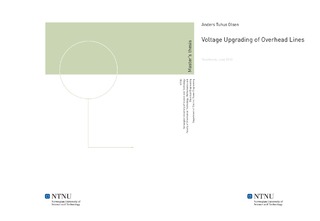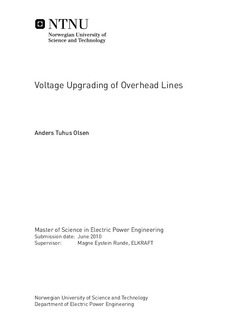| dc.description.abstract | Statnett wants to increase the transmission capacity in their 300 kV overhead lines by upgrading the operating voltage to 420 kV. To make this possible some modifications must be done. Insulator strings have to be elongated by two to four insulators and the air clearances must be checked. EN standards provide guidelines for how to calculate the air clearances adequately to provide required safety margins.It turns out that the formulas given by the standards provide greater safety margin than appropriate for upgraded transmission lines. By finding new proper safety margins, several towers which otherwise would have to be rebuilt to fulfill the requirements for clearances, can stay unmodified. When considering the number of towers in an average transmission line, there is obviously a great potential for saving money by putting some effort looking into proper minimum air clearances. By reduce the air clearance by approximately 10 cm, 6.5 mill. NOK were spared in a 65 km transmission line. It is therefore desirable to calculate the air clearances on the basis of smaller safety margins than described in the standard, but which is still within acceptable safety limits. In the formulas for minimum distances, the statistical withstand voltage U50%, gap-factors and altitude factors are examined for the cases of operating voltage, switching impulse and lightning impulse.Discrepancies between test results from a laboratory work conducted by STRI and calculations based on the EN standard of U50%, have been discovered. Tested U50 for switching impulses are 5 9 % higher than U50 from the standard. The same applies for lightning impulses where the tested value is 12 % higher than the standard. This gives reason to assume the standard to be somewhat conservative.Further, discrepancies are found between the standard EN 50341 that says that the gap factor when an insulator is present is the same as if no insulator is present, and Cigré report 72, which says that the gap factor should be corrected for the presence of insulators. Correction for insulators will lead to a lower gap factor i.e. lower break down strength along the insulator string than in the rest of the air gap. It turns out that the combination of rain and insulator string reduce the gap factor and thus, the withstand strength in the cases of switching impulses in the order of 6-13 % for V-string insulators and 20-34 % for I-string insulators and for continuous power frequency voltage in the order of 25 % for V-string insulators and 33-40 % for I-string insulators.Rain has no influence on the withstand strength of I-strings or V-strings exposed to lightning impulses.Several previous researches [1][2] shows the same tendencies of lack of correlation between U50 and gap factors when air gaps with insulator strings are exposed to lightning impulses. Thus, the gap factor is not sufficient to describe the discharge characteristics of air gaps with insulator strings exposed to lightning impulses.It is found that the air gap between phase and guy wire has approximately 7 % greater withstand strength than over the insulator string in a tower window. This additional safety margin is a desirable property in terms that the guy wires are the weakest point of a tower. This should however be verified by full-scale laboratory tests as this is mainly valid for the case of only the conductor-guy wire gap without the presence of the other air gaps that represent the tower window. | nb_NO |

